|
|
DSC Tech Library
 This section of our technical library presents information and documentation relating to Call Center technology and Best Practices plus software and products.
Since the Company's inception in 1978, DSC has specialized in the development of communications software and systems. Beginning with our CRM and call center applications, DSC has developed computer telephony integration software and PC based phone systems. These products have been developed to run on a wide variety of telecom computer systems and environments.
This section of our technical library presents information and documentation relating to Call Center technology and Best Practices plus software and products.
Since the Company's inception in 1978, DSC has specialized in the development of communications software and systems. Beginning with our CRM and call center applications, DSC has developed computer telephony integration software and PC based phone systems. These products have been developed to run on a wide variety of telecom computer systems and environments.
The following article relates to call center technology or customer service best practices and techniques.
Contact Center Best Performers and Best Practices
Source:Steve Cain, Gartner Measurement
Source:Earl Steman, Gartner Measurement
Writer: Carolyn LeVasseur, Gartner Measurement
Leveraging the best practices of top-performing contact centers is critical for optimizing contact center performance. Key to this endeavor is balancing costs and customer satisfaction.
Increased efficiencies can be achieved by structuring the contact center so that a greater percentage of callers can negotiate the automated system themselves to obtain any required information (e.g., via the World Wide Web or interactive voice response — IVR). Such an approach can result in significant savings (see Figure 1). The numbers cited in this article reflect those in the Gartner Measurement database of comparative metrics. The average contact center in the Gartner Measurement database deflects 16 percent of its contacts to self-service technology. The best performers deflect approximately 30 percent of calls to self-service. Gartner predicts that by 2006, the percentage of contacts that are handled through self-help will exceed 50 percent for best-performing enterprises (0.7 probability).
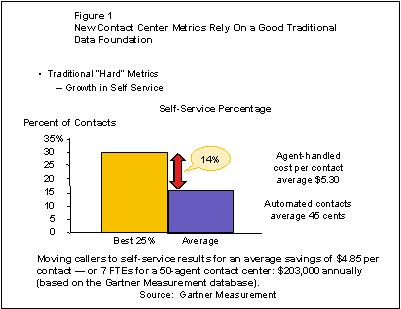
Whereas the average cost per handled contact is $5.30, the average cost for a self-service contact (assuming properly sized automation tools) is 45 cents. Thus, a potential exists of saving $4.85 per handled contact, which is substantial. For example, a 50-agent center handling 70,000 contacts per month would render a potential saving of seven full-time equivalents (FTEs) of center capacity. This is calculated by taking a typical contact volume of 70,000 calls per month times 14 percent, which equals a possible 9,800 self-service contacts that could be handled per month. When 9,800 contacts per month is divided by the average productivity of 1,400 contacts handled per agent per month, the total FTEs equals seven. Applying an average of $29,000 per FTE results in a saving of $203,000 per year.
Agent productivity can be a good source of hard return-on-investment data. The difference in average talk time per handled contact between an average performer and a best-in-class performer is 1.3 minutes per handled call. This represents a 26 percent advantage for better performers (see Figure 2). The primary source of this gap lies in the tools that are used (e.g., computer-telephony integration — CTI, IVR, incident tracking and expert systems) as well as the training of the agents.
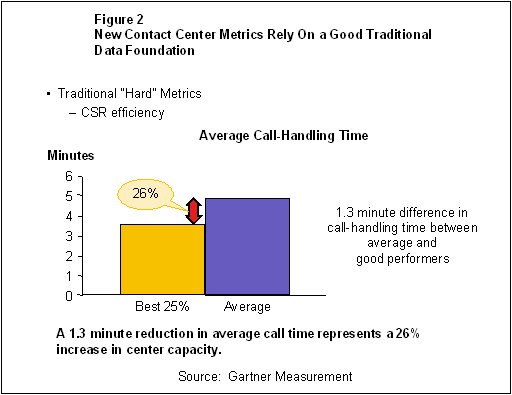
Conservatively, a 26 percent increase in agent productivity results in the ability to handle 364 more calls per agent per month (assuming 1,400 calls per month per agent as the current database average). For a 50-agent contact center, that equates to an "additional" 13 FTEs in call-handling capacity. At an average of $29,000 per FTE, an enterprise would realize a potential increase in productivity worth $377,000 annually.
As a contact channel, voice represents more than 90 percent of contacts for the average contact center. However, many contact centers invest in Web chat and e-mail technology before implementing an IVR or other voice-specific technologies (see Figure 3). For most contact centers, prioritizing voice service and cost optimization before investing in alternate channels is a better strategy. Before incorporating alternate channels, it is crucial to focus on improving voice operations procedures including agent monitoring and feedback, exception handling, workflow optimization and incentive systems.
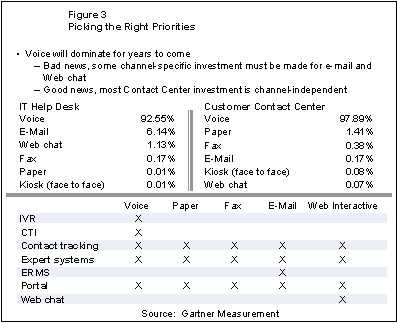
Regardless, many technologies required for voice optimization also benefit other channels. These technologies include those for expert systems, contact tracking and universal queue (i.e., portal).
Although the emergence of Web-based e-business is significant, in 2001 more than 97 percent of all retail sales in the United States still occurred in brick-and-mortar retail stores. However, people increasingly use the Internet for research prior to purchasing a product in a store or calling an 800 number.
To maximize customer relationship management (CRM), enterprises must identify and fill their significant contact center technology gaps. Some technologies utilized by best-in-class enterprises include (see Figure 4):
Computer-telephony integration — The best centers use CTI (through customer-entered digits in the voice response unit — VRU — or automatic number identification) to access the database for customer account information. Subsequently, the data appears before an agent in a screen pop.
Call/incident tracking — Most good help desks have systems that enable tracking of calls by type, account histories and problem resolution, even after service dispatch. The best customer service centers track calls at the aggregate level, but a few have contact management systems that allow them to perform detailed statistical analyzes and determine trending.
Expert/knowledge-base tools — These tools provide an agent with problem diagnosis or call-processing capabilities (i.e., scripting, online text searches or decision trees that assist an agent in recommending a solution) to reduce diagnosis time and resolve issues with the initial call.
Interactive voice response — IVRs provide information to callers without the interaction of an agent. These work especially well for circumstances in which a contact center receives a large volume of calls requesting predictable information.
Workflow management — Back-office information is routed automatically, thus speeding the processing of the information that is gathered.
Agent-scheduling software — This tool assists in the optimization of the number of agents available to answer calls, aligning agent count with call volume.
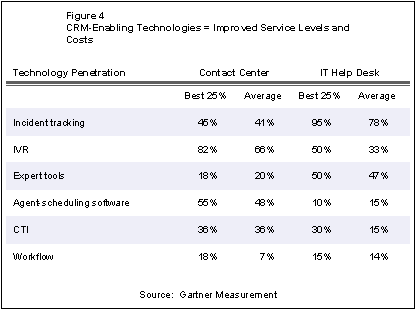
To understand a contact center's performance, it is imperative that the appropriate metrics are evaluated and compared with those of similar enterprises. The Gartner Measurement consensus model methodology ensures that the cost and service elements that are common to all centers are captured consistently to provide the basis for valid comparative analyzes. The consensus model tracks all costs associated with processing a customer call from the moment that it is received by the center until the point at which it either is resolved or, in the case of the help desk, appropriately dispatched for service (see Figure 5). These costs include all personnel, network, equipment and facilities charges that are associated with the center, regardless of whether these charges specifically appear as line items in a center manager's operating budget. Thus, the consensus cost model captures the costs of many pieces of an overall CRM strategy.
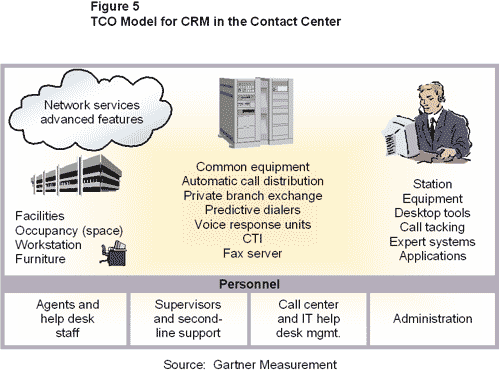
Top performers seek the assistance of an objective outside party that utilizes a consensus model methodology to ensure consistency and enable comparisons with other similar contact centers. Such centers benefit by gaining insights regarding opportunities for improvement and best practices that facilitate an appropriate balance between cost-efficiency and customer service.
|


 This section of our technical library presents information and documentation relating to Call Center technology and Best Practices plus software and products.
Since the Company's inception in 1978, DSC has specialized in the development of communications software and systems. Beginning with our CRM and call center applications, DSC has developed computer telephony integration software and PC based phone systems. These products have been developed to run on a wide variety of telecom computer systems and environments.
This section of our technical library presents information and documentation relating to Call Center technology and Best Practices plus software and products.
Since the Company's inception in 1978, DSC has specialized in the development of communications software and systems. Beginning with our CRM and call center applications, DSC has developed computer telephony integration software and PC based phone systems. These products have been developed to run on a wide variety of telecom computer systems and environments.




